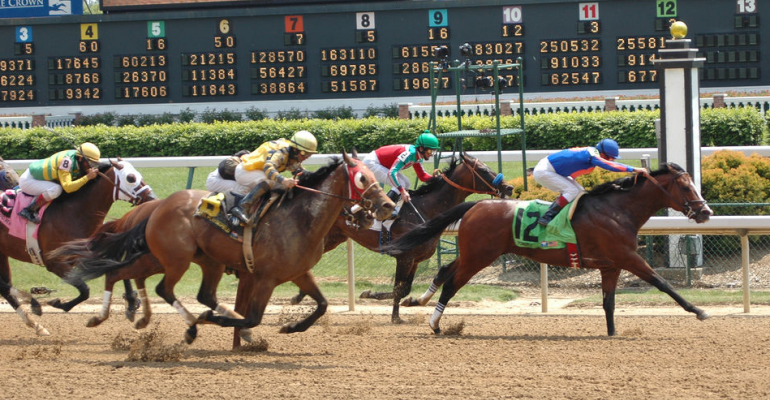The Kentucky Derby is the longest running sports event in American history. Held the first Saturday in May, three-year-old thoroughbreds gather at Churchill Downs in Kentucky to compete over a blistering two minutes that ends with a blanket of roses draped over the winner. While winning is worth millions, racing horses is a risky endeavor. Fortunately, current conditions in the economy and markets appear to be improving, encouraging corporate leaders, investors, and even horse owners to take the risk and invest.
Thoroughbreds are costly and speculative investments. The prices paid reflect the general willingness of horse owners to take risks. As a result, they are a good indicator of the strength of the economy. Sales of the leading thoroughbred horse auctioneer, Keeneland, fell during the recessions of 1990–91, 2001, and 2008–09, and then rebounded as conditions improved. The lingering weakness in thoroughbred sales over the past five years, 2009–2013, as they remained near levels seen 15 years earlier, coincided with a sluggish global growth environment, as can be seen in the similarly weak pace of business spending on new buildings to expand employees and output. [Figure 1]

Fortunately, it seems that the risk-taking environment has recently changed and horse sales are bolting out of the gate this year. The median price of two-year-old thoroughbreds in training at this year’s April auction has broken out to a new all-time high of $200,000, up over 30% from last year, suggesting a new environment of risk taking by horse owners may be emerging. Likewise, the environment for investment and risk taking by business leaders appears to be improving. In each of the past several years, the LPL Financial Current Conditions Index (CCI), our index of 10 real-time economic and market conditions, remained in a range of 200 to 250, indicating conditions for steady, but sluggish growth. But just last week, the CCI sprinted to 269—a new post-recession high. [Figure 2]
A breakout in economic growth from the steady, but sluggish pace of the past few years is necessary to support stock market valuations that rose in 2013 in anticipation of better growth ahead. While delayed by weather, it appears the race is on, growth may be breaking out, and the winner may be investors. The breakout in the CCI is another sign that the animal spirits of business leaders and investors may be re-emerging, resulting in more investment that may herald better growth.

Â
What is the CCI?
We constructed the LPL Financial Current Conditions Index early in 2009 as conditions were deteriorating in the aftermath of the financial crisis that was precipitated by the bankruptcy of Lehman Brothers in mid-September of 2008. Our goal was to create a weekly, fact-based measure of the conditions that underpin our outlook for the markets and economy in 2009.
We chose to create our own index tailored to the current environment to provide the clearest and most useful way to track how conditions are aligned with the expectations embedded in our investment recommendations. It was not intended to be a leading index or predictive of where conditions are headed, but a coincident measure of where they are right now. We want to track the conditions in real-time to aid in investment decision making. The CCI became a useful tool to describe the conditions most relevant to investment decision making in 2009 and contributed to our decision to begin to add risk to portfolios beginning late in the first quarter of 2009 as the markets bottomed and conditions began to improve.
The CCI proved to be a valuable investment decision-making tool in 2009 as it succeeded in tracking real-time conditions in the markets and economy. The drivers of the markets and economy change both during and across business cycles. From time to time changes to the index constituents are required to ensure the index incorporates those factors that are most critical to assessing the conditions in the markets and economy going forward.
IMPORTANT DISCLOSURES
The opinions voiced in this material are for general information only and are not intended to provide specific advice or recommendations for any individual. To determine which investment(s) may be appropriate for you, consult your financial advisor prior to investing. All performance reference is historical and is no guarantee of future results. All indices are unmanaged and cannot be invested into directly. Past performance is no guarantee of future results.
The economic forecasts set forth in the presentation may not develop as predicted and there can be no guarantee that strategies promoted will be successful.
Stock and mutual fund investing involves risk including loss of principal.
This research material has been prepared by LPL Financial.Â
To the extent you are receiving investment advice from a separately registered independent investment advisor, please note that LPL Financial is not an affiliate of and makes no representation with respect to such entity.





